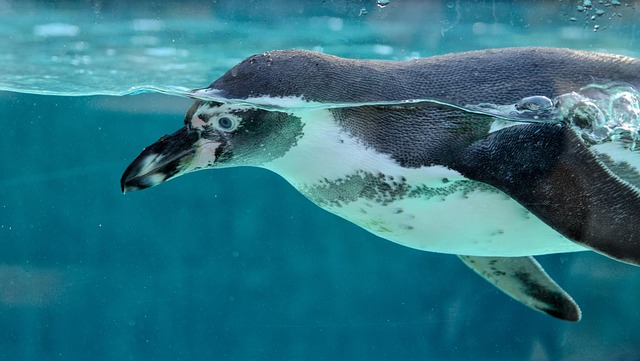Aquarium exhibits are evolving into eco-friendly, artful spaces that blend education and conservation. Using sustainable materials, renewable energy, and interactive elements, these displays engage visitors and protect marine life. By combining stunning visuals with hands-on experiences, aquariums inspire stewardship for oceans, fostering real action towards sustainability. Innovative aquarium exhibits set global standards, demonstrating the power of these facilities as powerful educational tools and environmental advocates.
“Revolutionize your understanding of marine conservation with eco-friendly aquarium exhibits—a harmonious blend of innovative design, public engagement, and sustainability. This article delves into the strategies behind creating captivating displays that not only educate but also foster a deeper connection to our oceans.
From sleek, sustainable structures to community-driven initiatives, we explore how these exhibits are transforming the way we preserve marine life. Discover the impact of green technologies and learn from successful collaborations, offering a glimpse into the future of sustainable aquarium exhibits.”
Innovative Design for Marine Conservation
Aquarium exhibits are evolving, with a growing focus on innovative design that goes beyond traditional tank setups. Modern marine conservation exhibits prioritize ecological integrity and visitor engagement by mimicking natural habitats, facilitating easier access for research and conservation efforts, and enhancing the overall visitor experience. Architects and designers now incorporate elements like interactive displays, touch pools, and immersive environments that encourage exploration while fostering a deeper connection with the ocean’s wonders.
These cutting-edge aquarium exhibits not only provide a platform for showcasing diverse marine life but also serve as powerful educational tools. By incorporating sustainable practices and eco-friendly technologies, they set new standards in marine conservation. From advanced water filtration systems to energy-efficient lighting, these exhibits strive to minimize their environmental footprint while ensuring the health and well-being of aquatic ecosystems on display.
– Exploring eco-friendly exhibit structures and their impact on conservation efforts.
Eco-friendly exhibit structures are transforming marine conservation in aquariums worldwide. These innovative designs incorporate natural materials, renewable energy sources, and efficient waste management systems to minimize the environmental footprint of these facilities. By embracing sustainability, aquarium exhibits not only set a positive example for visitors but also contribute to the long-term health of marine ecosystems.
The impact of eco-friendly structures extends beyond aesthetics. They help reduce carbon emissions, conserve water resources, and promote biodiversity by creating habitats that mimic natural conditions. Additionally, these exhibits foster public awareness about conservation issues, encouraging visitors to adopt more sustainable practices in their daily lives. This harmonious blend of education and environmental stewardship makes eco-friendly aquarium exhibits powerful tools for marine conservation efforts.
Educational Value and Public Engagement
Aquarium exhibits offer a unique opportunity to educate the public about marine conservation and sustainability in an engaging, interactive environment. By combining stunning visuals with informative content, these exhibits can spark curiosity and foster a deeper understanding of ocean ecosystems. Visitors can learn about the impact of human activities on marine life, explore solutions for protection, and discover the beauty and fragility of our oceans.
Public engagement is a key aspect of successful eco-friendly aquarium exhibits. Interactive displays, hands-on experiences, and guided tours encourage visitors to actively participate in the learning process. These engaging elements help bridge the gap between knowledge and action, inspiring folks to become stewards of the sea. Ultimately, by increasing public awareness and understanding, aquarium exhibits play a vital role in promoting sustainable marine conservation practices.
– Strategies to create engaging aquarium exhibits that educate visitors about marine sustainability.
Creating engaging aquarium exhibits that educate visitors about marine sustainability requires a multifaceted approach. One key strategy is to integrate interactive elements, such as touch pools and hands-on activities, which allow visitors to directly engage with marine life and gain a deeper understanding of its importance in the ecosystem. Incorporating multimedia presentations, virtual reality experiences, and live demonstrations by marine biologists can also enhance the learning experience by providing diverse and dynamic content.
Additionally, showcasing real-world conservation efforts and success stories through collaborative partnerships with environmental organizations adds authenticity to the exhibits. Displaying sustainable practices used in aquariums themselves, like recycling systems and energy-efficient lighting, serves as a tangible example for visitors. These approaches not only entertain but also inspire action, fostering a sense of responsibility towards preserving our oceans.
Eco-friendly marine conservation exhibits in aquariums are not just visually stunning; they also play a crucial role in public engagement and education. By employing innovative design principles and prioritizing sustainability, these exhibits can raise awareness about marine ecosystems while fostering a deeper connection between visitors and the natural world. Through interactive learning experiences, aquariums can inspire folks to become stewards of our oceans, ensuring a brighter future for both marine life and human communities.
